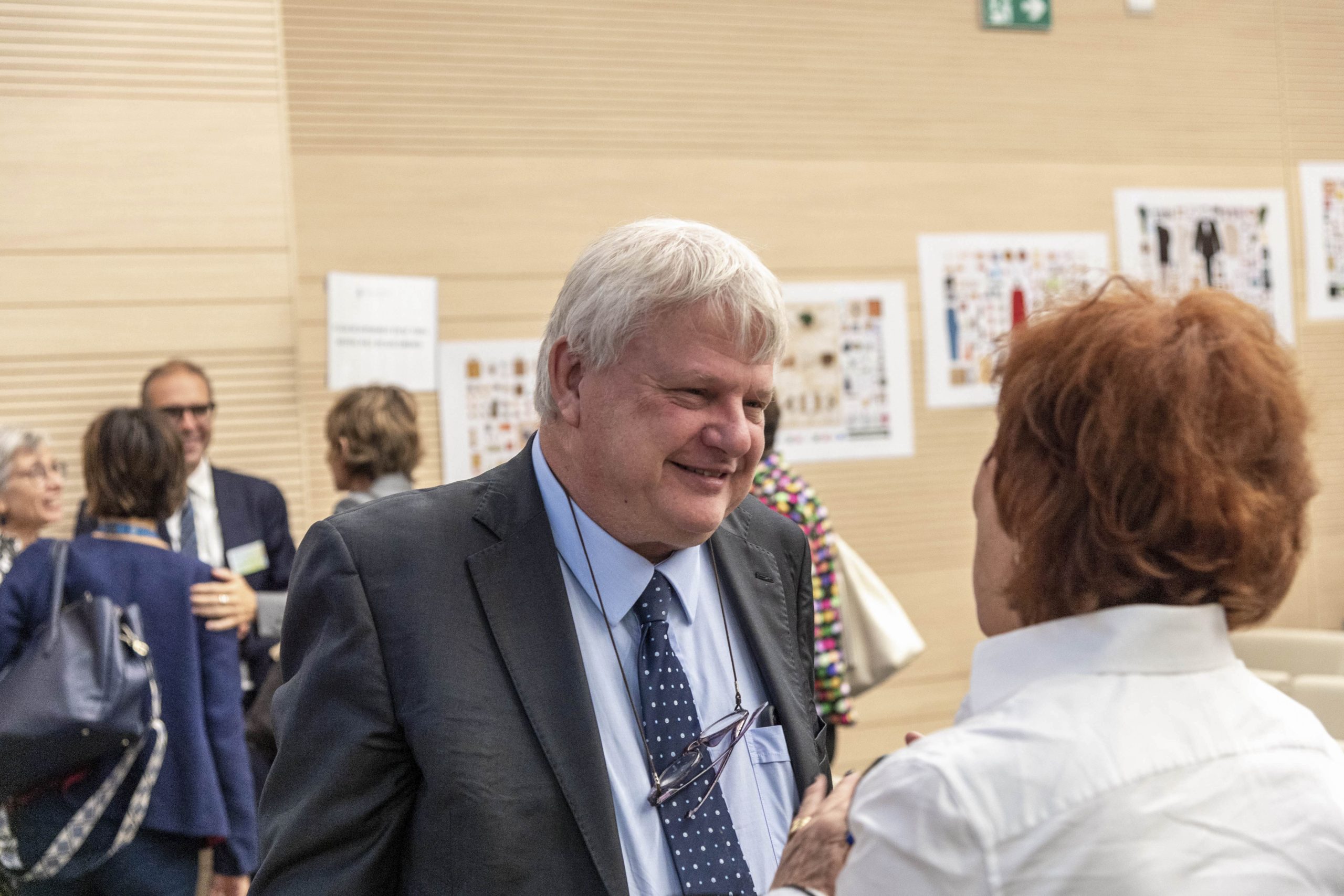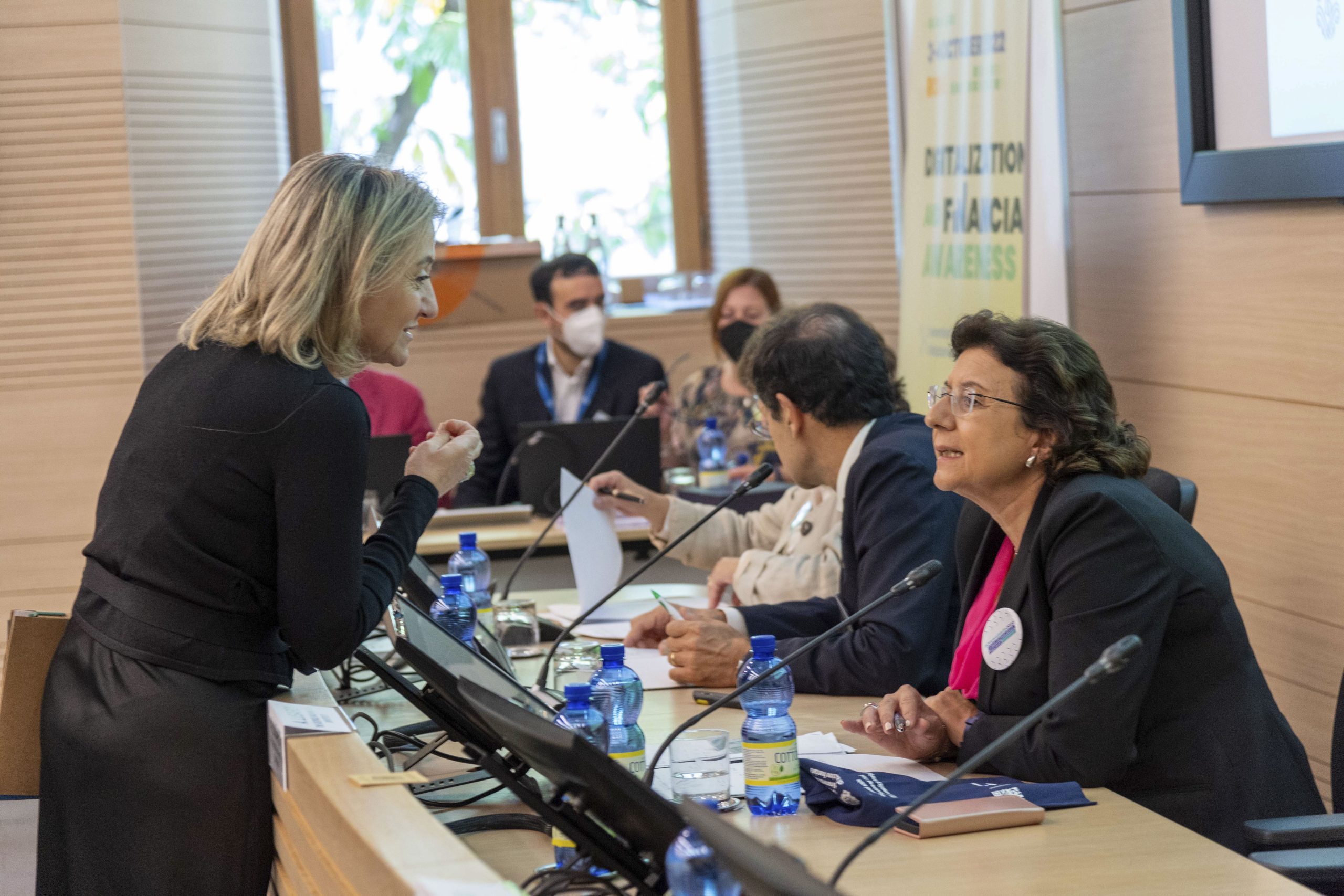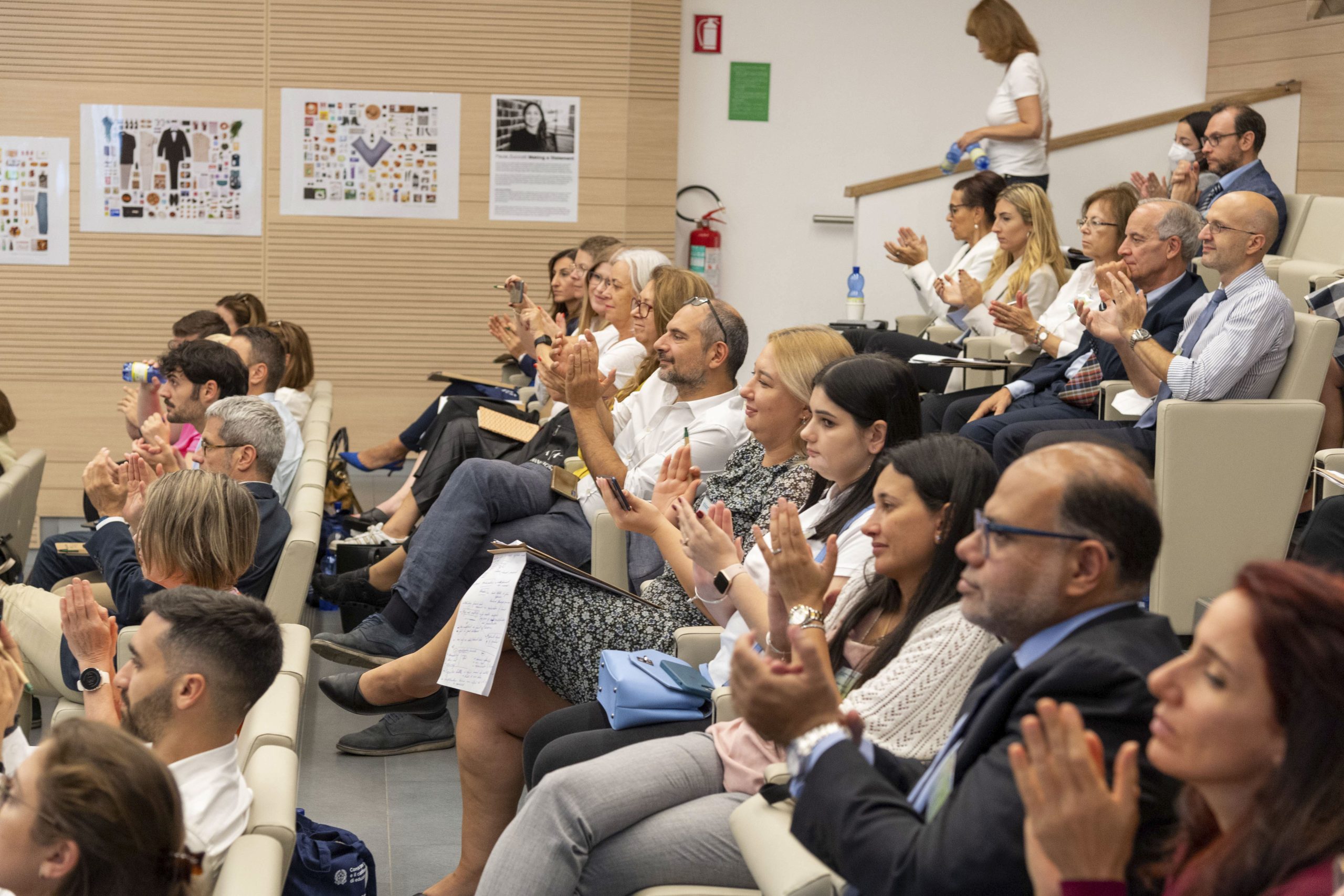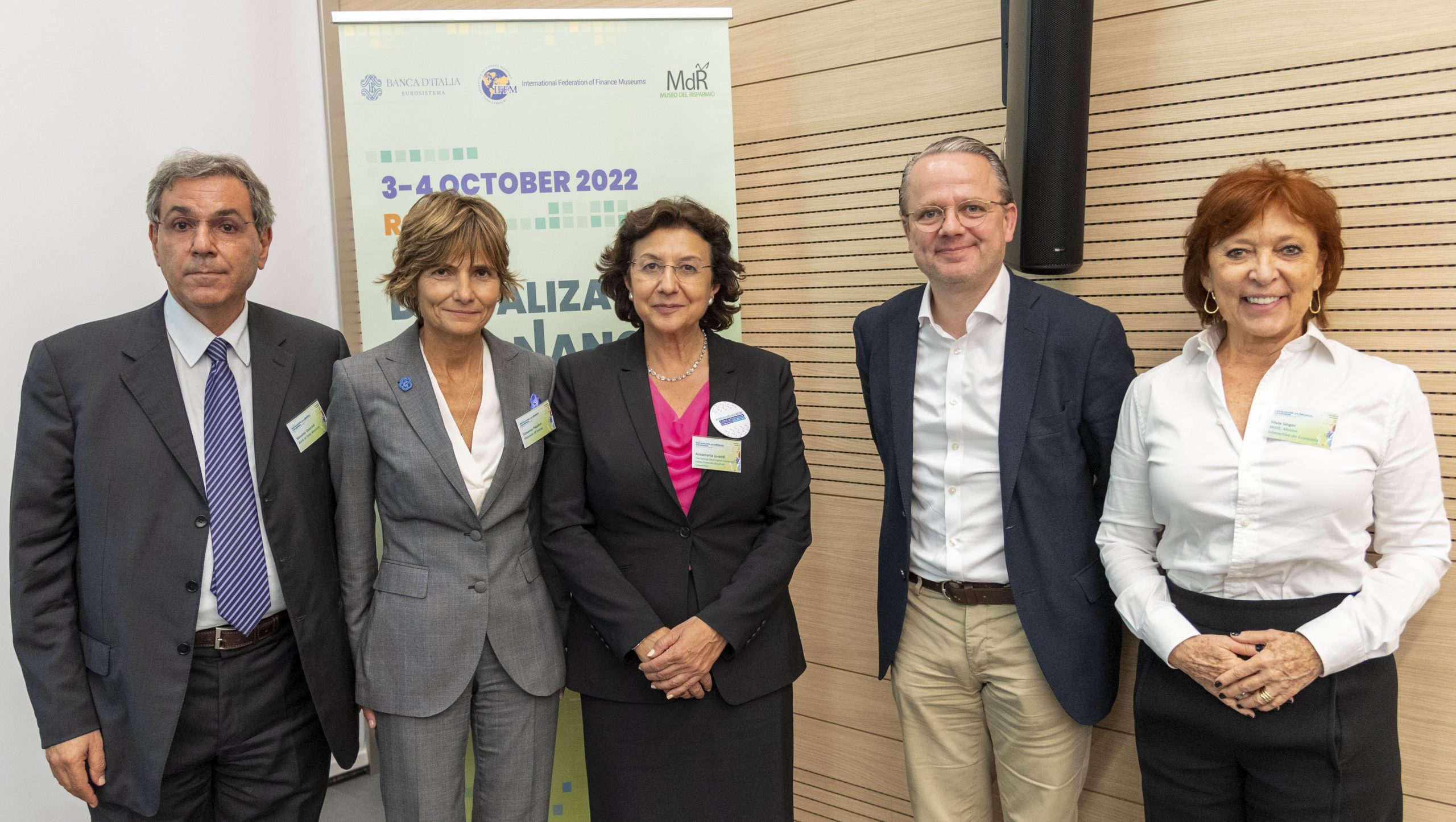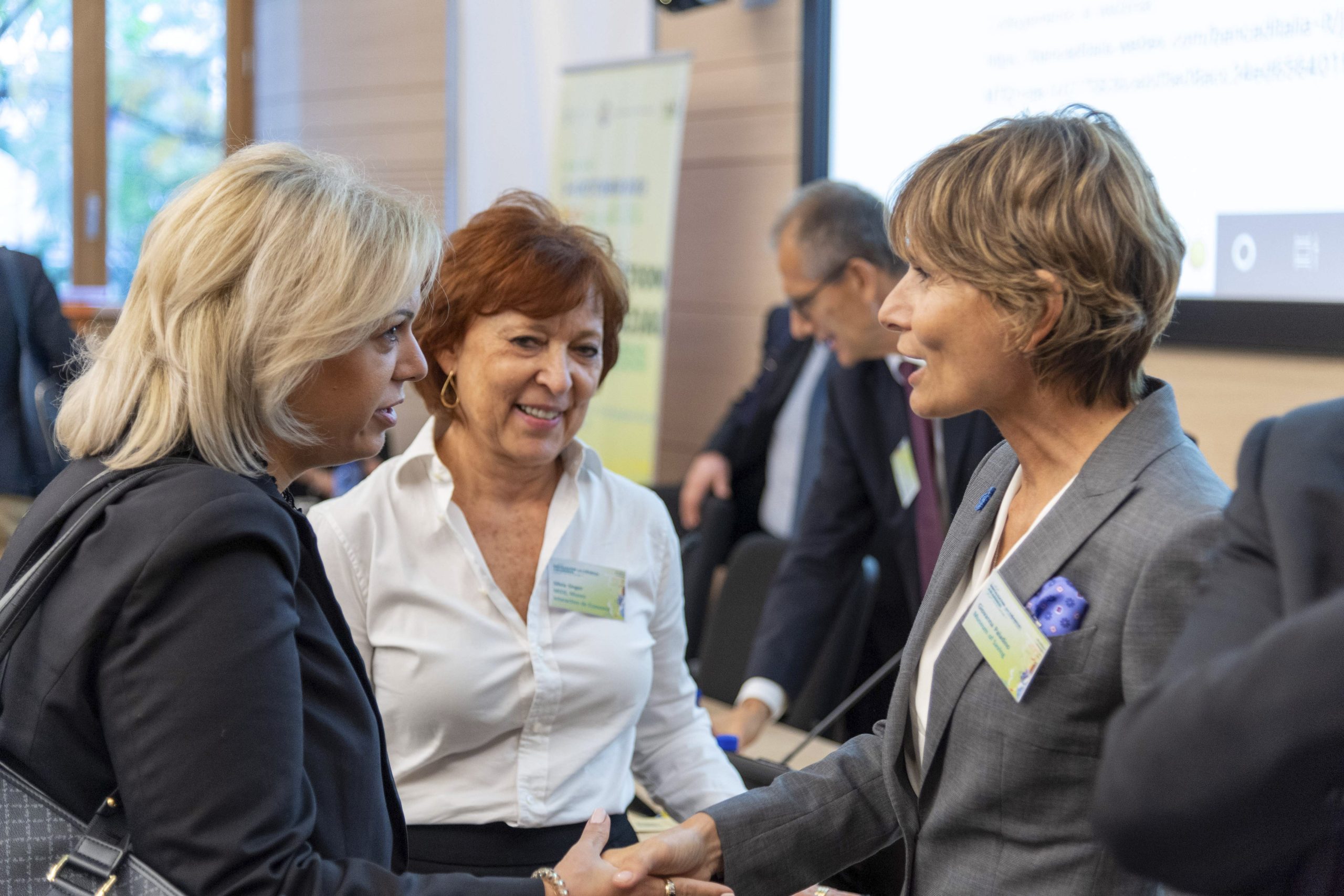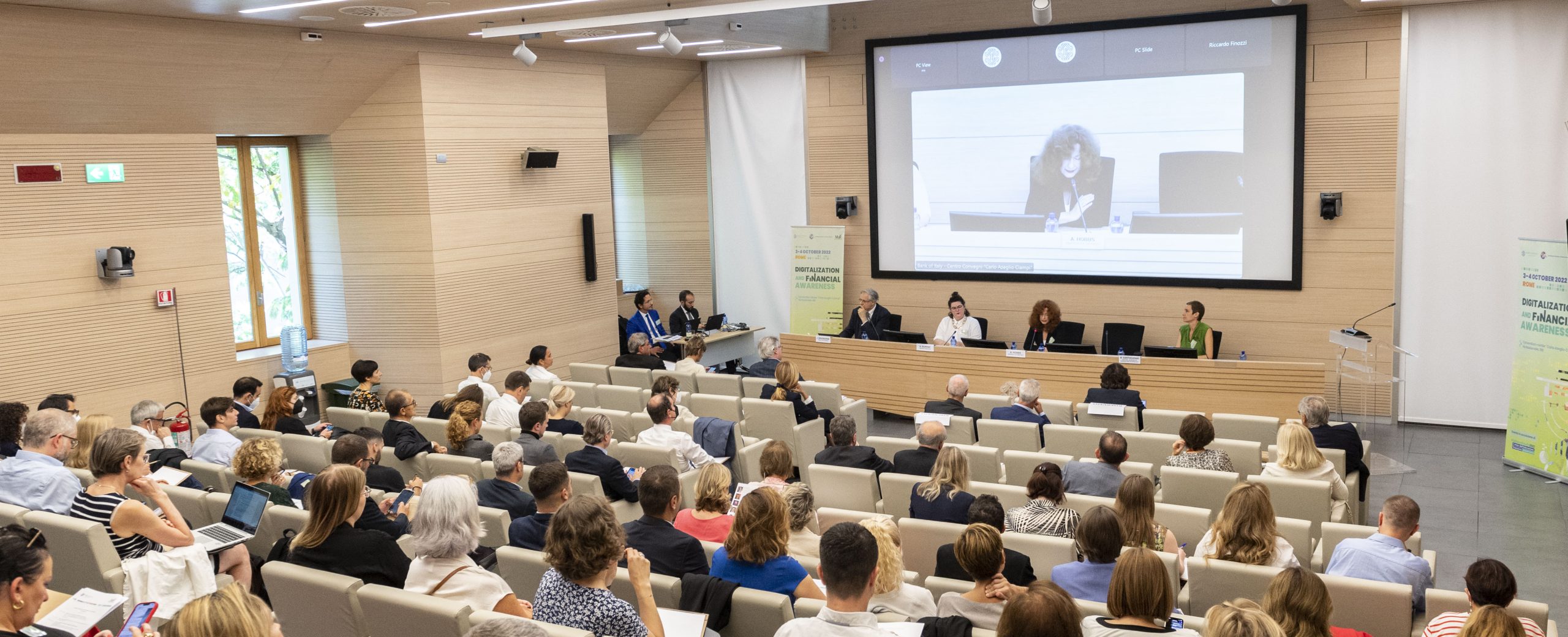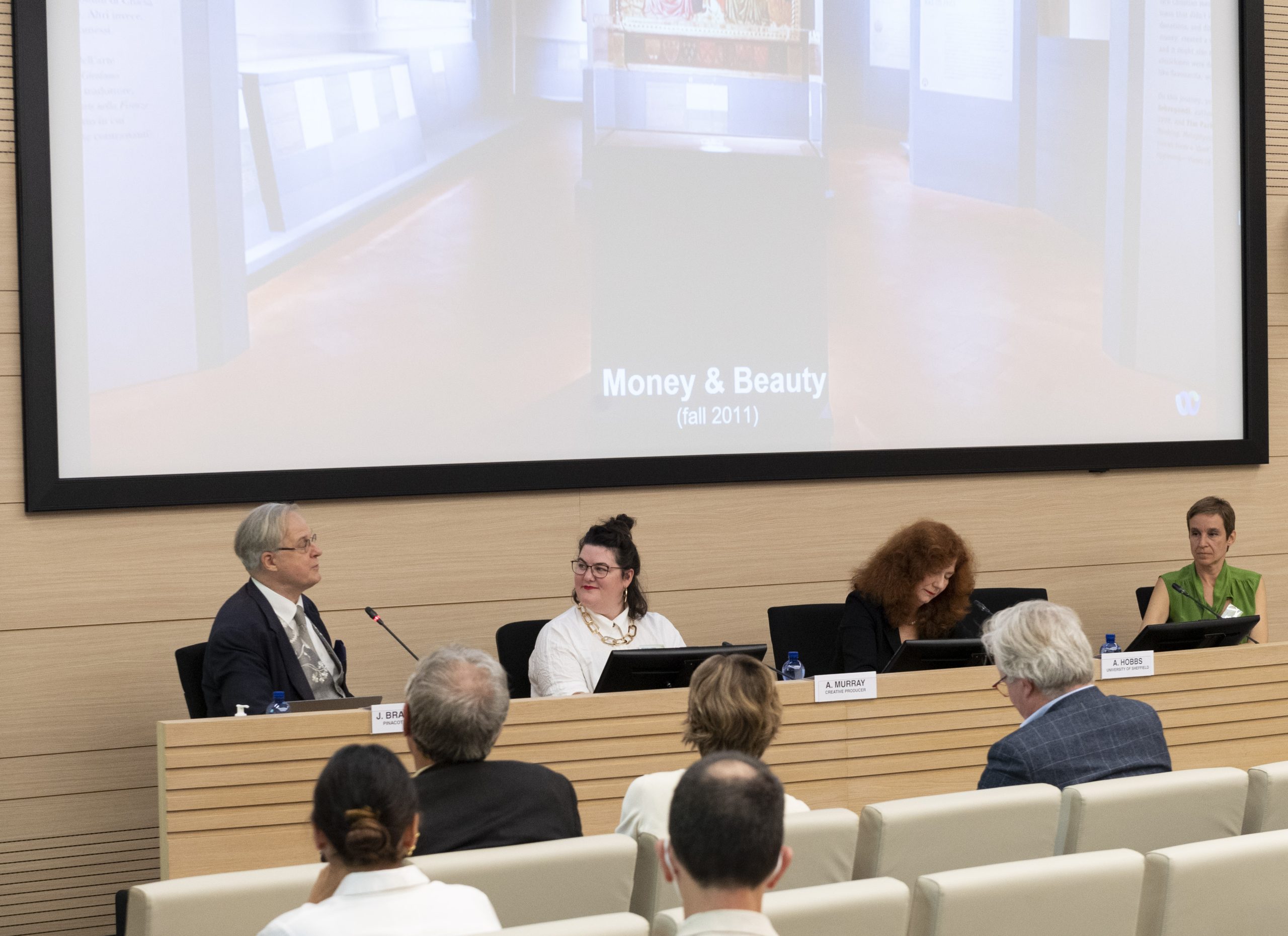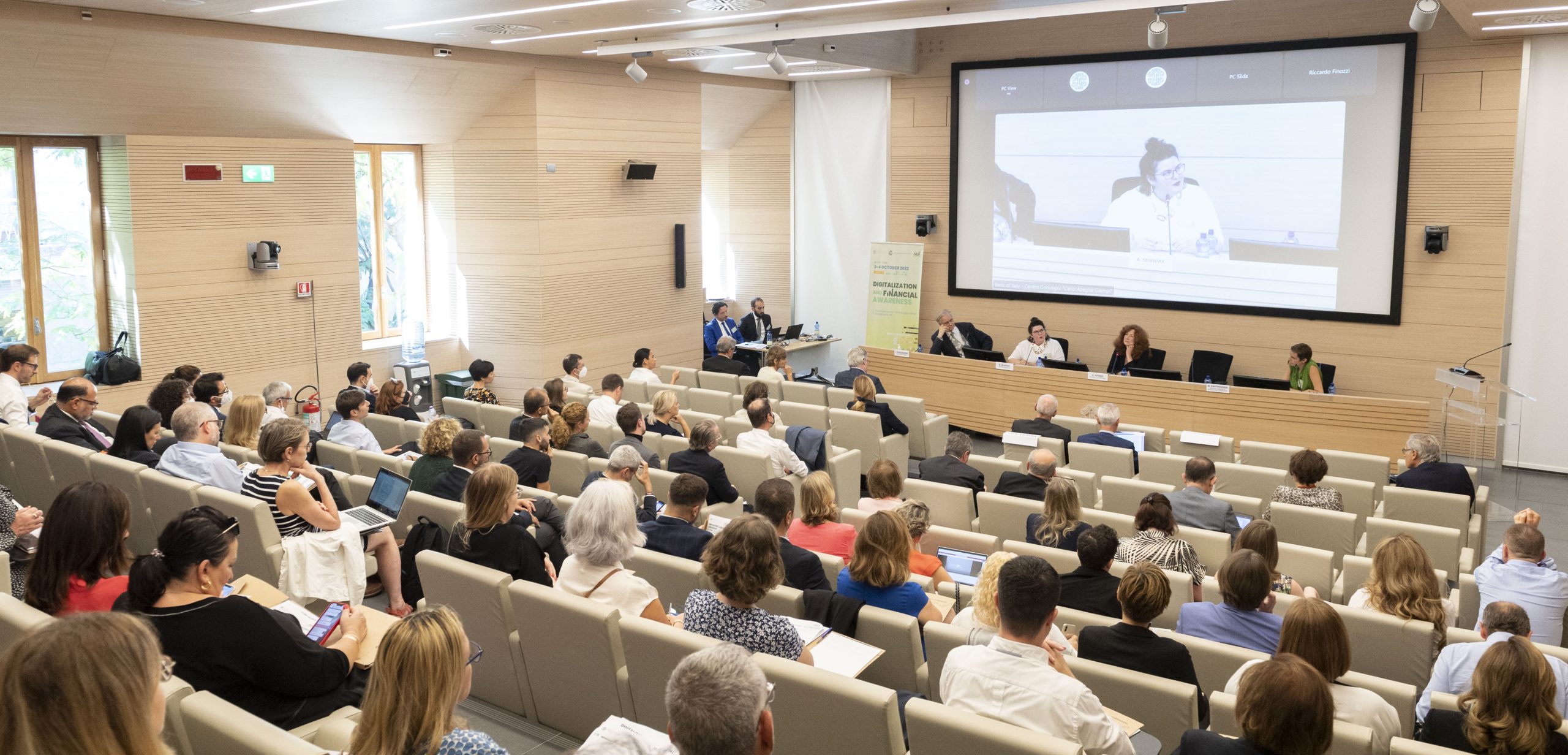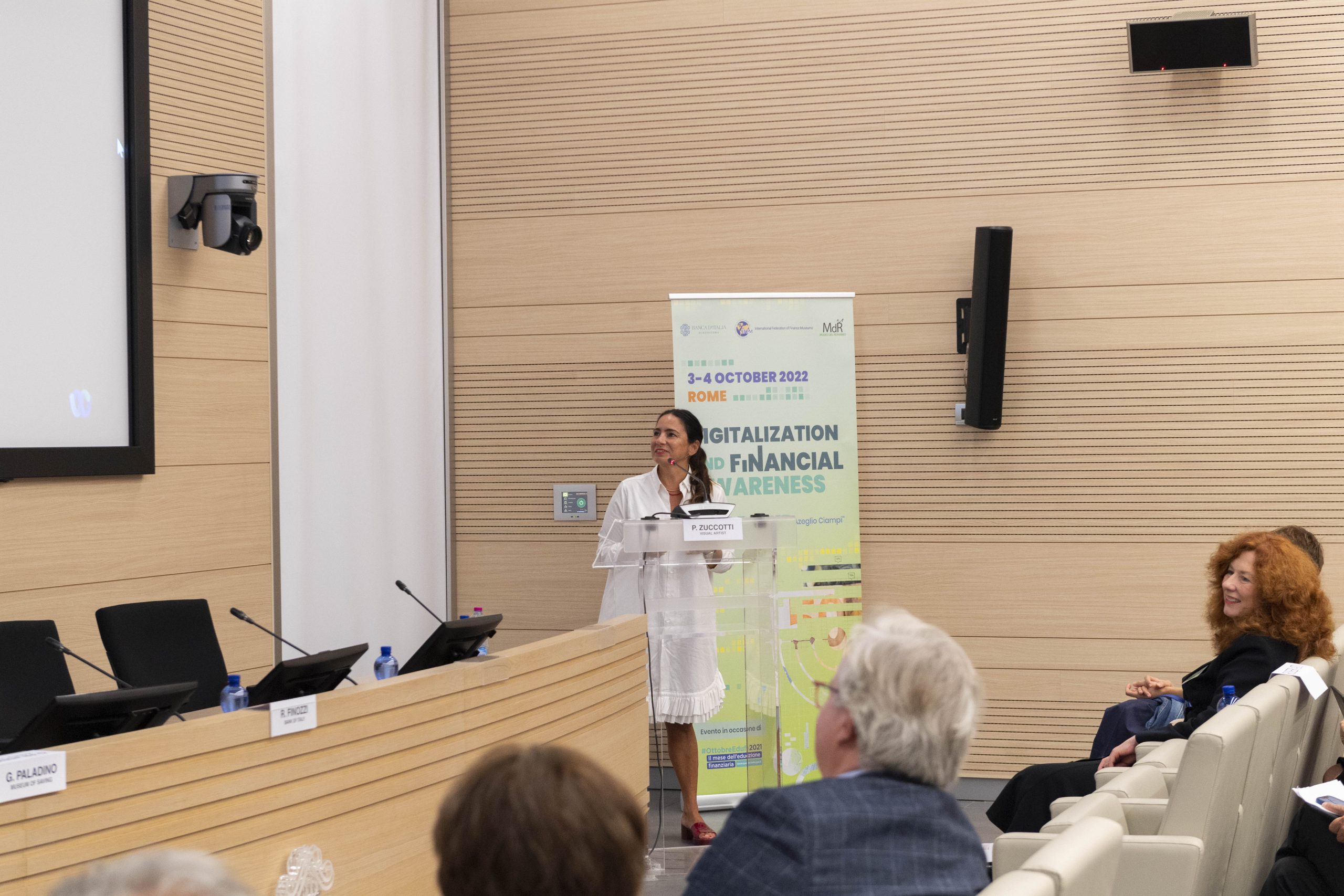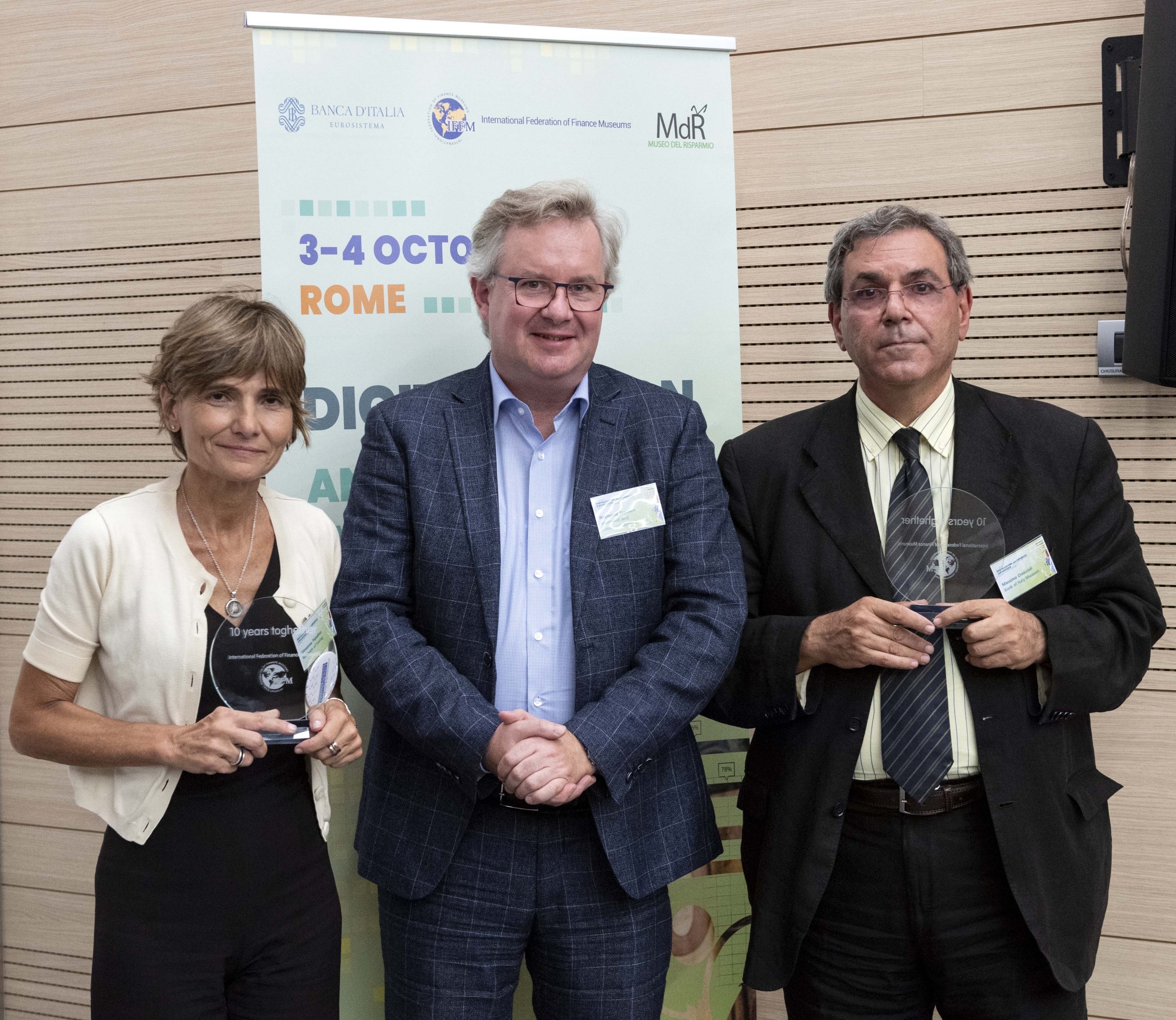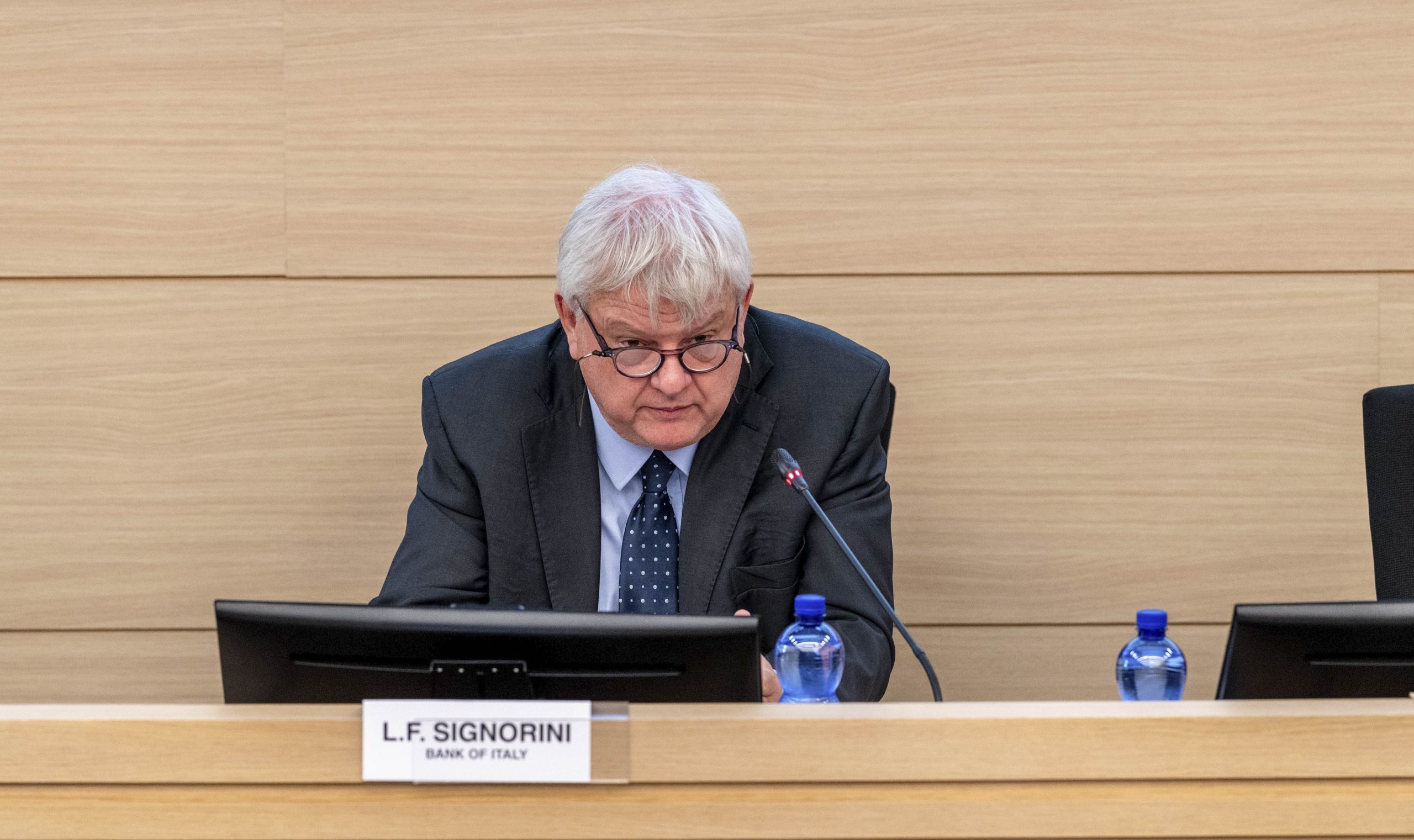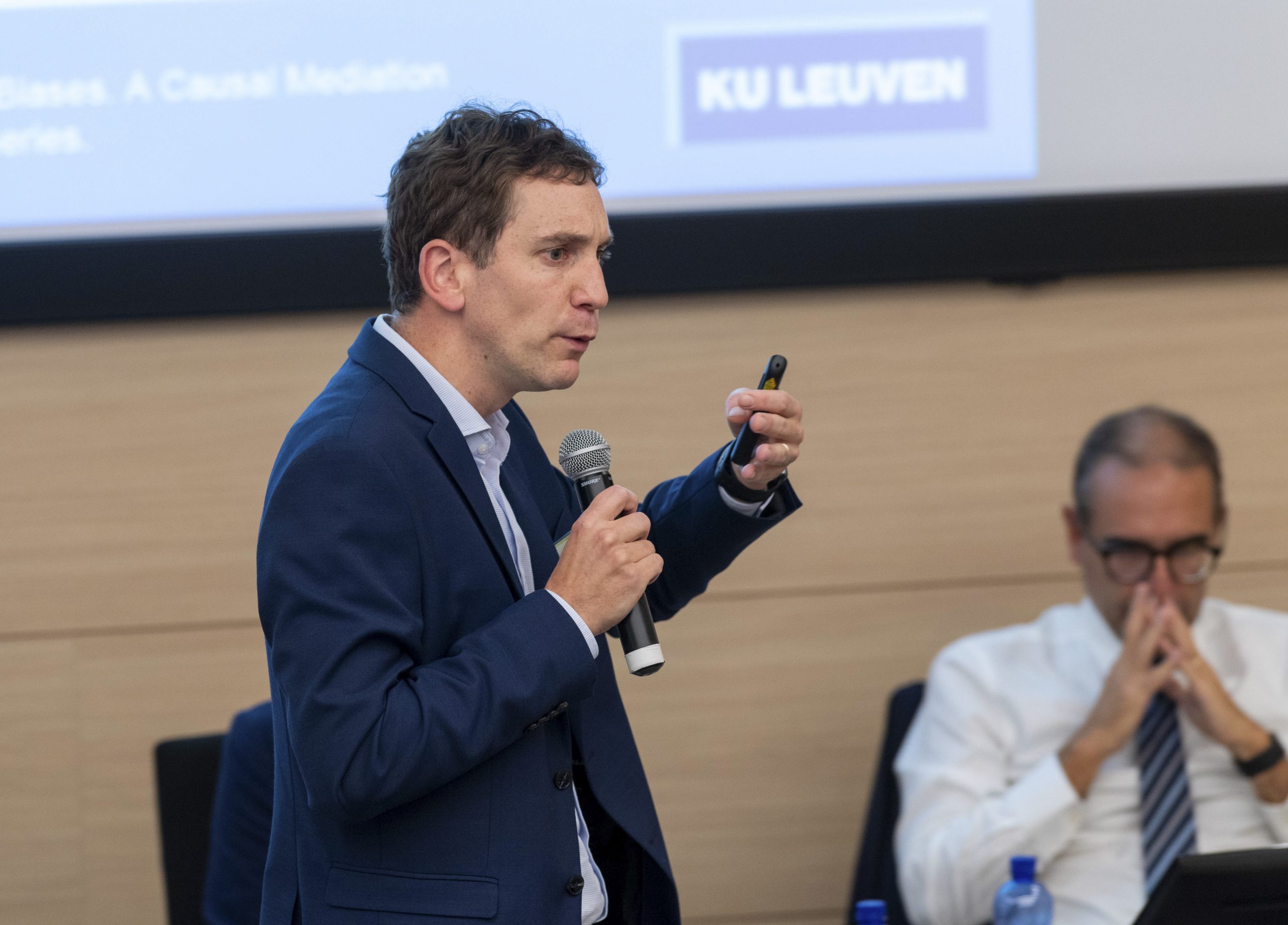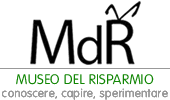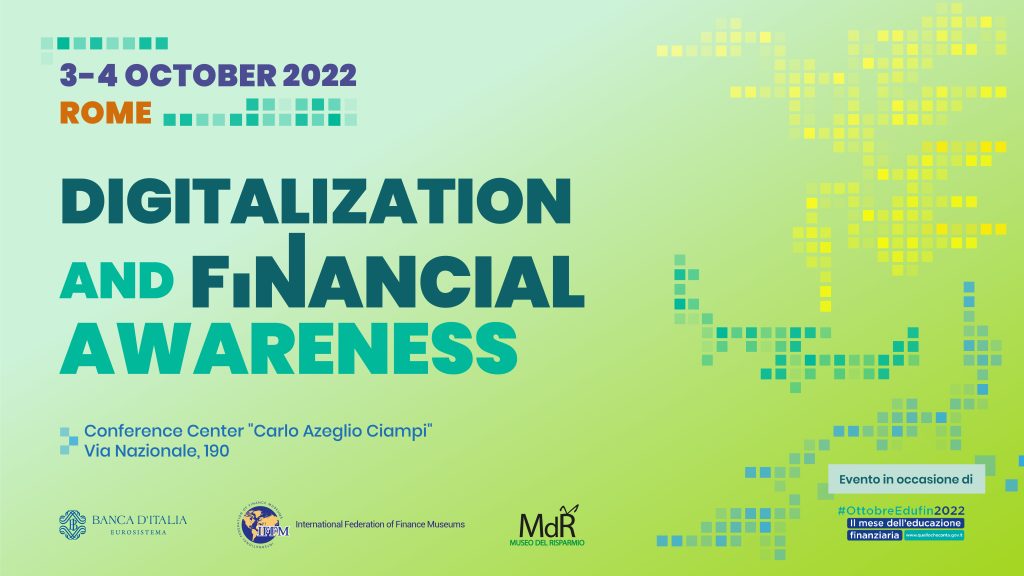
The International Conference “Digitalization and Financial Awareness”, organized by the Bank of Italy and the Museum of Saving on the occasion of the tenth Annual Meeting of the IFFM – International Federation of Finance Museums, took place in Rome on 3 and 4 October 2022
The conference organizers invited several speakers – from famous Italian and international museums – to discuss the role of digitalization in learning processes and audience engagement, as well as the impact of digitalization on financial education and inclusion.
3 OCTOBER
Session 1 “Museums and Technologies: what’s different about Finance”
The morning panel focused on the theme of technology application in art and science Museums. Maria Xanthoudaki (National Museum of Science and Technology Leonardo da Vinci), James Bradburne (Pinacoteca di Brera) and Aisling Murray (Science Gallery Dublin), offered an overview on the use of digital devices in their museums.
On the assumption that learning at the museum is not based on what the museum wants to teach but rather on what the visitor comes across, develops and assimilates during his/her visit, through research, experimenting, imagination, emotional engagement and narrative, Xanthoudaki highlighted how technology is important to create the right conditions of the visitor’s emotional involvement (in every museum). Digitalisation must in fact become a way to create a conversation with the materials of the museum, to enhance the aesthetic experience, to create objects that stimulate reflection. It shall not be the purpose of the museum, and not even just a tool but an environment where visitors create experience and comprehension.
Learning in the digital era: frontiers, challenges and transformations in the museum field – Maria Xanthoudaki, Director of Education and the Centre for Research in Informal Education (CREI) at the National Museum of Science and Technology DOWNLOAD THE SLIDES OF THE SPEECH
According to Bradburne, one should speak of “user” rather than “visitor”, namely a customer of the museum, and therefore of its materials – including the digital ones – and of the available experiences. The experience of a digital visit becomes then a complement to the physical one and offers the opportunity to deepen some aspects that are not caught during the physical visit , by offering a comprehensive experience to the user. Taking into account user’s needs is therefore essential, and these shall be studied in depth.
When art and technology meet: the visitors’ experience – James Bradburne, Director of Pinacoteca di Brera DOWNLOAD THE SLIDES OF THE SPEECH
Last but not least, Aisling Murray highlighted how museums are places where it is possible to trigger curiosity, reflection and above all dialogue on specific topics, a first step towards in-depth study. As indicated by the latest definition of Museum, provided by ICOM, in fact “A museum is a not-for-profit, permanent institution in the service of society that researches, collects, conserves, interprets and exhibits tangible and intangible heritage. Open to the public, accessible and inclusive, museums foster diversity and sustainability. They operate and communicate ethically, professionally and with the participation of communities, offering varied experiences for education, enjoyment, reflection and knowledge sharing”. The contribution of technology, with its spectacular nature and ability to trigger engagement, is thus important and necessary, as well as interdisciplinarity, which envisages a research strategy that comes across different disciplinary boundaries (music, Stem, photography, etc) to create a holistic approach.
Public Engagement & Technology: a Transdisciplinary approach – Aisling Murray, Creative Producer DOWNLOAD THE SLIDES OF THE SPEECH
Session 2 “Recent developments of finance museums”
Riccardo Finozzi, Communication Expert of the Bank of Italy, presented the project of the Money Museum of the Bank of Italy, where the transformation of a traditional museum into a powerful educational experience brought to the comparison between immersive and interactive approach. Starting from the best practice of science museums, where new technologies (such as the “virtual reality”) have been used to create a digital environment where users could interact, Finozzi explained how the Bank of Italy new museum decided to focus on technology too, but without ignoring that in order to provide to the visitor a truly full-immersion experience, not only an interactive one, leveraging on empathy is necessary. Technology is therefore essential but on its own it doesn’t make an experience «immersive». To trigger immersivity, feelings and emotions are needed (also using real objects – such as coins), they shall inspire the visitor, rather than teach him/her. DOWNLOAD THE SLIDES OF THE SPEECH
The work of Paula Zuccotti, Industrial designer, ethnographer, trends forecaster, creative strategist and visual artist, showed how a cold bank statement might turn into a work of art and how the latter might make people think about their life style and their ability to manage money. The exhibition “every thing we touch” aims to encourage people to think in a different way how their money is spent and have a better approach with their bankroll, showing a visual representation of consumers’ monthly expenditure. LOOK AT THE PHOTO OF THE ADVERTISING CAMPAIGN “Everything we touch”.
In the final part of the afternoon session, seven finance museums, belonging to national central banks and the private sector, had the chance to present how they developed their activities during the pandemic experience: in many cases the technological evolution prevailed, while in other instances the analogical aspect succeeded. Either way, everybody seized the opportunity to explore or complete a restructuring process of their premises.
Speeches:
- Maria Babosik, Project Advisor Budapest Finance Museum DOWNLOAD THE SLIDES OF THE SPEECH
- Manos Kordakis, Deputy Director of Centre for Culture, Research and Documentation Bank of Greece DOWNLOAD THE SLIDES OF THE SPEECH
- Doris Langner, Representative head of Financial Literacy Division – Oesterreichische Nationalbank DOWNLOAD THE SLIDES OF THE SPEECH
- Ann Lavens, Director of BELVue Museum – Koning Boudewijnstichting DOWNLOAD THE SLIDES OF THE SPEECH
- Philip List, Director of Erste Financial Life Park DOWNLOAD THE SLIDES OF THE SPEECH
- Kirsty Parsons, Exhibitions Officer of Bank of England Museum DOWNLOAD THE SLIDES OF THE SPEECH
4 OCTOBER
Session 1 “The impact of digitalization on financial education and inclusion”
The opening address of Luigi Federico Signorini, Senior Deputy Governor of the Bank of Italy, highlighted how digitalization in finance might create both benefits and risks: innovations make it in fact more efficient, but also more distant from being properly understood by non-expert users. “The gradual dematerialisation of monetary and financial instruments, the depersonalisation of the procedures involved in disbursing loans, the fact that physical bank networks are becoming rarer, increase the invisibility of finance”, he explained, adding that the last statement is related to the fact that certain people are attracted by crypto-assets, that are even more invisible than traditional instruments, as well as much riskier.
For this reason, most central banks are now actively engaged in financial education and economists are dealing with the need of being involved in public debate. Financial education is not meant to influence people’s preferences, but to teach them how to make the best use of available information when choosing between technical alternatives that are not easy to understand. The presence of cognitive shortcuts makes it more difficult as it requires a debias work.
In order to be effective, financial education must create connections with history and other subjects. Clarity and simplicity of materials are fundamental, it is important not to take for granted the starting background of single users.
What can digitalization do? On one hand, with the digitalisation the ability of spreading messages increases, on the other the network often contains information that can be difficult to understand or that can be misunderstood. Usually we use information that strengthen what we think we already know. Breaking this vicious cycle is not easy. “Because of digitalisation, the educational challenge is becoming simultaneously easier and more complex. Perhaps we need to cultivate methods of teaching that – beside basic technical literacy aim to argument ‘epistemic understanding’, i.e. the critical thinking that helps to select sensible theories and reliable sources, in finance as well as elsewhere”. DOWNLOAD THE FULL TEXT OF HIS SPEECH
At the end of this session, the video intervention of Andreas Schleicher, Director for Education and Skills, OECD, focused on the delay in financial education of Italians teenagers, by pointing out that, although parents remain a key reference point, schools might do a lot for the most vulnerable teens, who haven’t models to be inspired by at home: researches suggest in fact that especially the most disadvantaged have less knowledge and skills in terms of money management. For this reason, financial education at school is crucial: it is not enough that a country’s wealth rises to produce an increase in its level of financial literacy, whereas it is demonstrated that talking about finance at home and at school produces positive effects, since it is not a theme of secondary importance, financial decisions are taken by everybody in everyday life..
Panel discussion “The potential benefits of digitalization on financial education and inclusion”
Leonardo Becchetti, Professor of Economics, Tor Vergata University of Rome, Agar Brugiavini, Professor of Economics, Ca’ Foscari University of Venice and Annamaria Lusardi, University Professor of Economics and Accountancy, The George Washington University and Director, Italian Financial Education Committee took part in the roundtable.
Leonardo Becchetti addressed the topics of the impact of and obstacles to financial education, in times of digitalization. First of all, the results of two experiments were showcased. The first one was conducted on a sample of Italian students in the last year of secondary school to measure the effects of financial education. He found that the participation to a customized modular course rose significantly the level of financial literacy (measured by multiple-choice questionnaire), in particular for those with higher scores in other topics and willing to study economics at university. The second one was conducted (by online questionnaire) on a sample of players of slot machines, video poker and scratch cards to inquiry the relationship between gambling and financial education: a lower probability of correct response to questions of financial education and a tendency of overestimating the winning possibilities emerged.
The main barriers to financial education, i.e. negative reputation of finance and lack of interest, were outlined. Overcoming the traditional teaching model by stimulating curiosity, giving learning a meaning and a scope, might be a possible solution. The experience of “generative finance” would represent a response: in fact, illustrating the positive impacts it might determine in the social and environmental fields, the interest towards financial education would increase and the reputation of finance would improve.
Last but not least, the great potential of digitalization has been recognized, but also its risks have been highlighted, as for example the spread of economic fake news and the prevailing over face-to-face relationships with experts, crucial for a good financial education.
Agar Brugiavini addressed then the topics of familiarity with finance and financial inclusion, also with regard to the digital world. A way to improve confidence in finance for young people, it might consist in a positive model offered by the context where they live: for example it would be very useful if parents talk at home about money, saving, planning, debt, investments.
As far as inclusion is concerned, it was highlighted how an obstacle is represented by, for example, vulnerability: for instance, older women, with low education and little money, are a fragile category, that have no means to access the world of finance, and therefore are forced to ask others to manage their money.
Anna Maria Lusardi finally, emphasized the importance (compared nowadays to the ability of reading and writing) of financial education and pointed out its effectiveness and efficiency.
Above all, it was brought up how markets and financial products are risky, and therefore an appropriate knowledge to access them is needed: thus. it was stressed how financial literacy is important and because introducing financial education into school programs is crucial. Especially if considering that knowledge enables not only to use instruments at disposal, but also to use them correctly, which promotes financial inclusion.
As proof of the importance of financial education, a meta-analysis, carried out on the most rigorous experiments on the topic, has been mentioned, it demonstrates its benefits and convenience: in fact, it was found that financial education is appropriate to produce positive effects (wide-ranging and not only temporary) both on know-how and behaviour, and that initiatives carried out are also cost effective.
On the contrary, the lack of financial education generates high costs: a scarce or null level of financial literacy is a sort of “tax on the poorest people”. For example, if you don’t know a mortgage can be negotiated, you will not do it, and will pay more interests, when you could have the opportunity to pay less, or you gamble a lot as you don’t understand the concept of probability.
In conclusion, the need to add financial education in school programs was reiterated; however they should be renovated, to become a workshop where young people learn to think critically. DOWNLOAD THE SLIDES OF THE SPEECH
Session 2 “Recent research on financial literacy and digitalization”
In his speech about “The Use and Effects of Digital Games in Education”, Panu Kalmi, Professor of Economics and Vice Dean at the School of Accounting and Finance, University of Vaasa explained that the use of a playful element in financial education activities is positive, because games allow to play different roles and have different point of views, to develop social skills and familiarize to team work, to adopt a long-term vision and concentrate on subjects that maybe under other circumstances wouldn’t have been considered of interest.
The use of playful elements is furthermore favoured by similarities between games and financial education: both require to reason by objectives, to maximize the use of scarce resources in case of constrains, to value costs-opportunities. Thanks to these touchpoints, a significative learning process is possible also outside formal educational frameworks, that is by games within unstructured teaching contexts.
Selecting the right games for the right occasions is also extremely important, as well as connecting them with the topics addressed in school programs and discussing ex post about the experiences students made..
DOWNLOAD THE SLIDES OF THE SPEECH
Kristof De Witte, Professor in Education Economics at the Faculty of Economics and Business at KU, Leuven, addressed the use of digital instruments in financial education to face the increasingly different educational needs, to change behaviours and to foster parents’ engagement.
Three different tests have been showcased, whose results have pointed out positive effects regarding all three areas of investigation. In fact, the use of digital instruments allows:
– with regard to heterogeneous classes, to increase on average financial expertise;
– with regard to financial attitudes, to improve them (also by rising the awareness of the mistake to give priority to a short-term vision);
– with regard to parents’ involvement in children’s education, to improve their (and their own) financial literacy, with persistent learning effects.
DOWNLOAD THE SLIDES OF THE SPEECH
The paper by Emilio Barucci, Professor of Financial Mathematics at the Polytechnic University of Milan, explored the effectiveness of online financial education lessons for university students. In an experiment conducted at the Polytechnic University of Milan, some students were asked to attend online financial education lessons, while others were invited to choose live ones: training (interest, timeframe, rating, bond prices, loans and amortization schedule) was preceded and followed by a test, both identical for any participant.
By comparing preliminary and conclusive tests, no significant differences emerged: when compared with students attending the in-person course, students of the online course were not found to be significantly worse, and both training activities have proved effective (above all with regard to female gender, to those who were at the beginning less interested to financial education, and to those with a higher university preparation), as all participants improved their financial skills considerably.
It can be argued, consequently, that online training is a valid alternative to the live one. DOWNLOAD THE SLIDES OF THE SPEECH
Finally the paper of di Daniela Marconi, Financial Education Directorate, Head of Young People, Analysis and Survey Division, Bank of Italy, Marco Marinucci, Financial Education Directorate, Economist in Young People, Analysis and Survey Division, Bank of Italy and Giovanna Paladino, Director and Curator of the Museum of Saving, demonstrated that, while digital skills help to strengthen the attitude to saving, for example also by the increasingly widespread use of apps to daily spare small amounts of money, they seem not to have an impact on the decision to invest the saved money. To switch from savers to investors, what matters is financial education. Investing in fact requires a high level of awareness of money, which is strictly connected to self-confidence and what is known about the functioning of the economy and of the financial system. Their study also highlights significant gender differences in investment behaviour, which are not found in terms of propensity to save. DOWNLOAD THE SLIDES OF THE SPEECH
On the occasion of the conference, a forest has been planted to compensate, at least to some extent, CO2 emissions generated by this event. The FIN-LIT forest contains 100 coffee, cocoa and papaya trees, that were planted in Colombia, Cameroon, Madagascar and Kenya, and they will absorb 10.25 t* of CO₂
Visit the forest: https://bit.ly/FINLITforest
